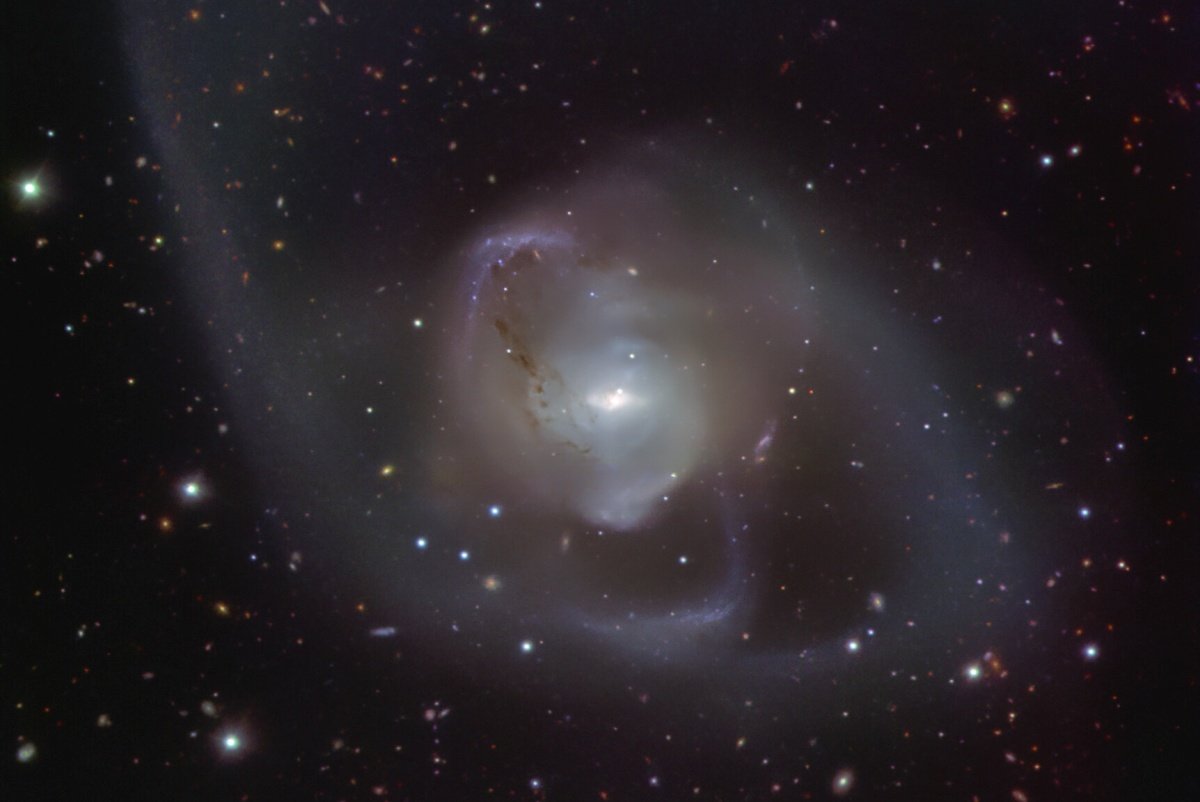Every week, TecMundo this #AstroMiniBR Bring together five interesting and fun astronomical curiosities produced by Twitter profile contributors to spread the knowledge of this oldest science!
#1: A galactic companion
Galaxies don’t stay alone forever, it’s pretty common for them to mingle with others.
An example is this pair of galaxies, NGC 7727, imaged by the VLT in Chile. Zoom in to the center of the image and you can also see supermassive black holes merging!#AstroMiniBR pic.twitter.com/z7CH885nNl
— Elismar Lösch ????????? (@LoschElismar) 17 August 2022
It’s rare to find one in the universe. galaxy alone. This is because galaxies in general are much more easily found in group and cluster environments, which contain a few tens to thousands of galaxies and often interact with each other over billions of years. Eventually, these interactions go on an inevitable collision course. When that happens, it’s not compared to a simple multiplication: it’s one of the most amazing phenomena in the universe!
The consequences of this cosmic shock are illustrated in the beautiful images above, recorded by the VLT telescope in Chile, and show NGC 7727, a pair of interacting galaxies located about 89 million light-years from Earth in the constellation Aquarius.
In the image, you can see astonishing detail both in the main body of the galaxy and in the faint tails of dust, gas and stars created by tidal interactions around it. You can also see the tangled scars as the two galaxies merged, tearing stars and dust apart to form the long arms surrounding NGC 7727. These arms are also young and full of extreme heat, seen in blue. in the image. Highlights are the two original galactic cores, each containing a supermassive black hole on its way to merge.
#2: A new look at old and familiar galaxies
The JWST telescope is changing the way we see galaxies!
By observing infrared, we can see more closely other features of galaxies such as heated dust!!
Hubble // JWST#AstroMiniBR pic.twitter.com/xXhdsTMmxI
— Camila Esperança (@astronomacamila) 19 August 2022
NASA’s James Webb Space Telescope (JWST) won’t stop surprising anytime soon!
He studied the Cartwheel Galaxy, shown above, in comparison to a previous Hubble telescope observation that revealed striking new details of star formation and the galaxy’s central black hole.
JWST’s high infrared observation capability made it possible to obtain these details of the Spinning Wheel Galaxy, along with its two smaller companion galaxies.
Located about 500 million light-years from Earth, this wagon-wheel-like galaxy is the result of a high-speed supercollision between a large galaxy and a small galaxy. This collision strongly affected the shape and structure of the galaxy: the Spinning Wheel has two rings, a bright inner ring expanding outward from the collision center, and a colored ring around it (just like ripples in water after a river or lake). a stone is thrown into it) and produces this exotic and magnificent view of a part of the Cosmos.
#3: Fingers of God
[#AstroMiniBR] When examining clusters of galaxies, we encounter a very interesting effect called “Fingers of God”: the distribution of galaxies seems to extend in the direction of the observer, forming structures that look like fingers (+) pic.twitter.com/EumoEKS5Ia
— Elismar Lösch ????????? (@LoschElismar) 13 August 2022
When you look at large-scale maps of the distribution of galaxies around our position in space, you can see that these galaxies have finger-like structures pointing to the Earth. You see clusters of galaxies pointing to Earth all over the sky.
What does it mean? Nothing in particular.
This is the effect called Fingers of God. It is caused by the peculiar velocities of galaxies that change the velocity of a galaxy relative to the motion stream of the universe, causing an excess in the Doppler shift beyond the redshift that light undergoes due to cosmological expansion. Didn’t you understand anything? Don’t worry. All this means that this is a completely natural effect and in no way proves that Earth is privileged in any way.
#4: The four seasons of the year
The end of winter brings us the question: why are there seasons?
incidence of sunlight varies throughout the year in the terrestrial hemisphere -> less insolation below the equator = winter in the southern hemisphere (junk-september) ??#AstroMiniBR
{c} Robert Simmon, @eumetsat pic.twitter.com/vJb7kTDdDR— yanna martins franco (@martins_yanna) 17 August 2022
Winter is coming to an end, and it’s not something to remember at all: it didn’t, isn’t, and won’t be caused by the Earth moving from the Sun to its maximum point.
The four seasons of the year are caused by the Earth’s rotation around its axis, creating day and night, while it moves around the Sun in an elliptical orbit. The Earth’s axis of rotation is inclined with respect to the orbital plane, and because of this tilt, the Earth does not always receive the same solar intensity during its orbit around the Sun. This is why the seasons occur.
When the Earth’s axis points to the sun, it is summer for that hemisphere. Winter occurs when the Earth’s axis diverges. In the middle of these two times, in spring and autumn, the Earth’s axis of rotation is 90 degrees from the sun. This means that on this date day and night are approximately the same length: 12 hours each, give or take.
#5: Looking at the past of the universe
The universe is so big that light takes a long time to travel. When we look at very distant galaxies, we see them as snapshots of the past.
The light from these galaxies turns red as shown below!#AstroMiniBR pic.twitter.com/O53NkfxKab
— Camila Esperança (@astronomacamila) 19 August 2022
One of the most common and most used terms by scientists in astronomy is redshift. Literally translated as redshift, it refers to the increase in wavelength and a corresponding decrease in the frequency and energy of the photon of electromagnetic radiation (such as light) emitted by some celestial bodies. In the universe this happens naturally due to cosmic expansion!
Source: Tec Mundo
I am Bret Jackson, a professional journalist and author for Gadget Onus, where I specialize in writing about the gaming industry. With over 6 years of experience in my field, I have built up an extensive portfolio that ranges from reviews to interviews with top figures within the industry. My work has been featured on various news sites, providing readers with insightful analysis regarding the current state of gaming culture.













